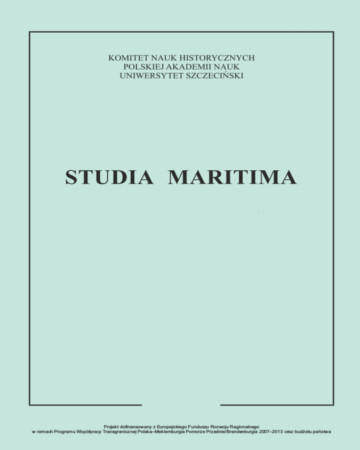






| Authors: |
Jerzy
Trzoska
Akademia Pomorska w Słupsku, Instytut Historii i Politologii |
| Keywords: | the sea route Stockholm-Gdańsk types of vessels sailor trade the second half of the 17th century and the beginning of the 18th century. |
| Data publikacji całości: | 2015 |
| Page range: | 15 (19-33) |
| 1. | Biskup M., Handel Gdańska ze Sztokholmem na przełomie średniowiecza i czasów nowożytnych, „Zapiski Historyczne” 1984, t. 49, z. 4, s. 36–49. |
| 2. | Bogucka M., Z zagadnień obrotów wewnętrznych regionu bałtyckiego: handel Gdańsk– Sztokholm w 1643 roku, „Zapiski Historyczne” 1978, t. 43, z. 4, s. 44–57. |
| 3. | Bogucka M., Gdańscy ludzie morza w XVI–XVIII w., Gdańsk 1984. |
| 4. | Bogucka M., Gdańsk a rewolucja w handlu bałtyckim XVII w., [w:] Strefa bałtycka w XVI–XVIII w. Polityka – społeczeństwo – gospodarka. Ogólnopolska sesja naukowa zorganizowana z okazji 70-lecia urodzin Profesora Edmunda Cieślaka, red. J. Trzoska, Gdańsk 1993, s. 115–121. |
| 5. | Brück T., Der Eigenhandel hansischer Seeleute vom 15. bis zum 17. Jahrhundert, „Hansische Geschichtsblätter” 1993, 111. |
| 6. | Gierszewski S., Wisła w dziejach Polski, Gdańsk 1982. |
| 7. | Groth A., Niektóre problemy załóg dawnych żaglowców, „Nautologia” 1971, z. 2. |
| 8. | Groth A., Rozwój floty i żeglugi gdańskiej w latach 1660–1700, Gdańsk 1974. |
| 9. | Groth A., Handel morski Elbląga z krajami Skandynawii w drugiej połowie XVII w., Zeszyty Naukowe Wydziału Humanistycznego Uniwersytetu Gdańskiego, „Historia” 1980, t. 10. |
| 10. | Groth A., Handel własny załóg marynarskich na przykładzie ich udziału w handlu morskim Kłajpedy i Elbląga, [w:] Czas i dokument. Studia nad procesem aktotwórczym. |
| 11. | Publikacja poświęcona Adamowi Muszyńskiemu, red. A. Wirski, Koszalin 1997. |
| 12. | Hagedorn B., Die Entwicklung der wichtigsten Schiffstypen bis ins 19. Jahrhundert, Berlin 1914. |
| 13. | Ilustrowana encyklopedia dla wszystkich. Okręty i żegluga, red. Z. Grzywaczewski, Warszawa 1977. |
| 14. | Kutrzeba S., Żeglarstwo wiślane w czasach Rzeczypospolitej Polskiej, Warszawa 1918. |
| 15. | Lepszy K., Dzieje floty polskiej, Gdańsk–Bydgoszcz–Szczecin 1947. |
| 16. | Nowáky G., Chłopi, lasy i kopalnie. Gospodarka Szwecji w okresie mocarstwowości, „Mówią Wieki” 1995, R. 28, nr 3 (430). |
| 17. | Staden på vattnet, t. 1: (1252–1850), utgiven av L. Nilsson, Stockholm 2002. |
| 18. | Svensk handelsstatistik 1637–1737, utgiven av B. Böethius, E.F. Heckscher, Stockholm 1938. |
| 19. | Szymański H., Deutsche Segelschiffe. Die Geschichte der hölzernen Frachtsegler an den Deutschen Ost- und Nordseeküsten vom Ende des 18. Jahrhunderts bis auf die Gegenwart, Berlin 1934. |
| 20. | Trzoska J., Dzieje gdańskiego statku „Fortuna” (1712–1731), Prace Muzeum Morskiego w Gdańsku, t. 8, red. P. Smolarek, Gdańsk 1979. |
| 21. | Trzoska J., Kaprzy króla Augusta Mocnego (1716–1721). Z problematyki morskiej czasów saskich, Prace Centralnego Muzeum Morskiego, t. 9, red. A. Zbierski, Gdańsk 1993. |
| 22. | Trzoska J., Zmienne koniunktury w handlu i żegludze gdańskiej, [w:] Historia Gdańska,t. 3, cz. 1: (1655–1793), red. E. Cieślak, Gdańsk 1993. |
| 23. | Trzoska J., Handel polsko-szwedzki w latach „potopu” na przykładzie kontaktów Gdańska ze Sztokholmem, [w:] Relacje polityczno-gospodarcze w rejonie Bałtyku XVII–XX w. Materiały z konferencji naukowej z 5 grudnia 1995, red. C. Ciesielski, Gdańsk 1996, s. 35–47. |
| 24. | Trzoska J., Działania wojenne a handel gdański w pierwszej połowie XVIII wieku, „Teki Gdańskie” 2003, t. 5, s. 265–275. |
| 25. | Trzoska J., Aus der Problematik der Schiffahrtskontakle zwischen Stockholm und Danzig in der zweiten Hälfte des 17. Jahrhunderts, „Studia Maritima” 2004, vol. 17, s. 23–37. |
| 26. | Trzoska J., Rosyjskie ingerencje w handel i żeglugę gdańską w pierwszej połowie XVIII wieku, [w:] Sąsiedztwo nadbałtyckie XVI–XX w. (Bałtyk – Elbląg – Gdańsk – Rosja). |
| 27. | Zbiór studiów, red. A. Romanow, Płock–Iława–Elbląg 2005, s. 21–42. |
| 28. | Trzoska J., Z problematyki kontaktów żeglugowych pomiędzy Sztokholmem a Gdańskiem w drugiej połowie XVII w., [w:] Po obu stronach Bałtyku. Wzajemne relacje między Skandynawią a Europą Środkową, red. J. Harasimowicz, P. Oszczanowski, M. Wisłocki, Wrocław 2006, s. 449–452. |
| 29. | Trzoska J., From the Issues of Navigation between Stockholm and Gdańsk in the First Half of the 18th Century, „Studia Maritima” 2007, vol. 20, s. 51–63. |
| 30. | Trzoska J., Z zagadnień żeglugi pomiędzy Sztokholmem a Gdańskiem w pierwszej połowie XVIII wieku, [w:] Miscellanea pomorskie, red. W. Skóra, Słupsk 2008, s. 33–42. |
| 31. | Trzoska J., Gdański handel i żegluga wobec zmian układu sił w Europie podczas wielkiej wojny północnej, „Słupskie Studia Historyczne” 2010, nr 16, s. 51–67. |